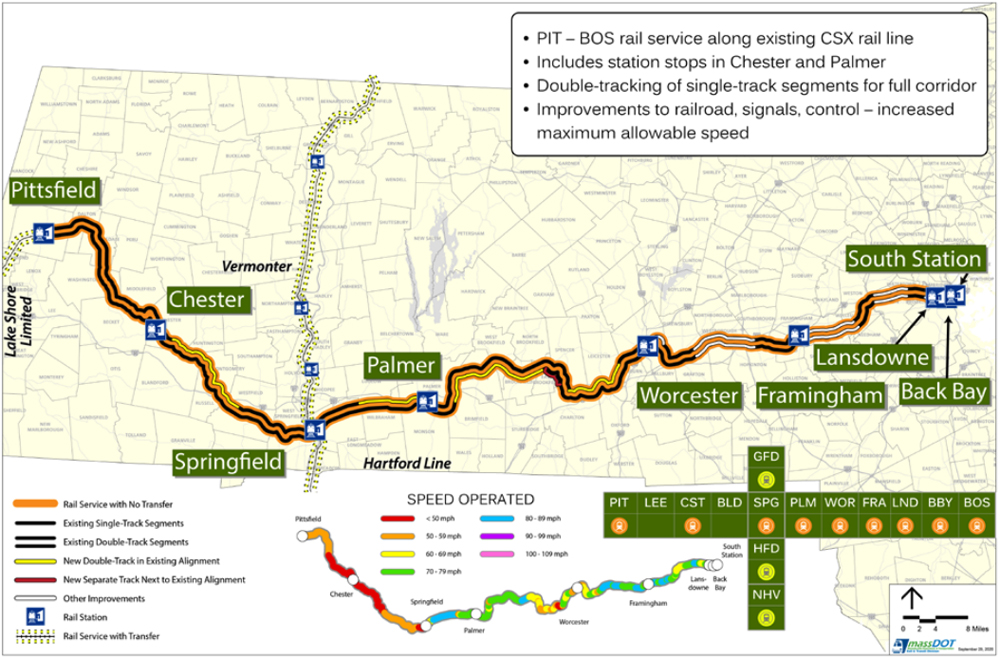
SPRINGFIELD, Mass. — U.S. and Massachusetts officials have reached agreement on a plan to develop the long-discussed East-West Rail project, which will extend existing rail service west from Worcester to Springfield and Pittsfield, Mass.
State House News Service reports Gov. Charlie Baker and Rep. Richard Neal (D-Springfield) announced the plan for the state legislature to create a new rail authority to capitalize on federal funding from the Bipartisan Infrastructure Bill passed last year.
“There’s an agreement on a path forward here,” Baker said. Creating the state authority, he said, “will then make it possible for us to leverage a lot of the available federal money … I think we’ve got a real opportunity.” Neal said the agreement hinged on including the authority in a pending state infrastructure bill and creating a dedicated funding stream for the project.
MassLive.com reports the project received a boost when Amtrak access to Springfield was included in the conditions for CSX to buy Pan Am Railways [see “Regulators approve CSX Transportation’s acquisition …,” Trains News Wire, April 14, 2022].
Many aspects of the agreement remain to be worked out, including a budget and a timeline for when service might begin. A 2021 report estimated costs for three alternatives for the project ranging from $2.4 billion to $4.6 billion, and suggested ridership would not be enough to qualify for federal funding [see “Digest: Report offers final alternatives …,” News Wire, Jan. 5, 2021].






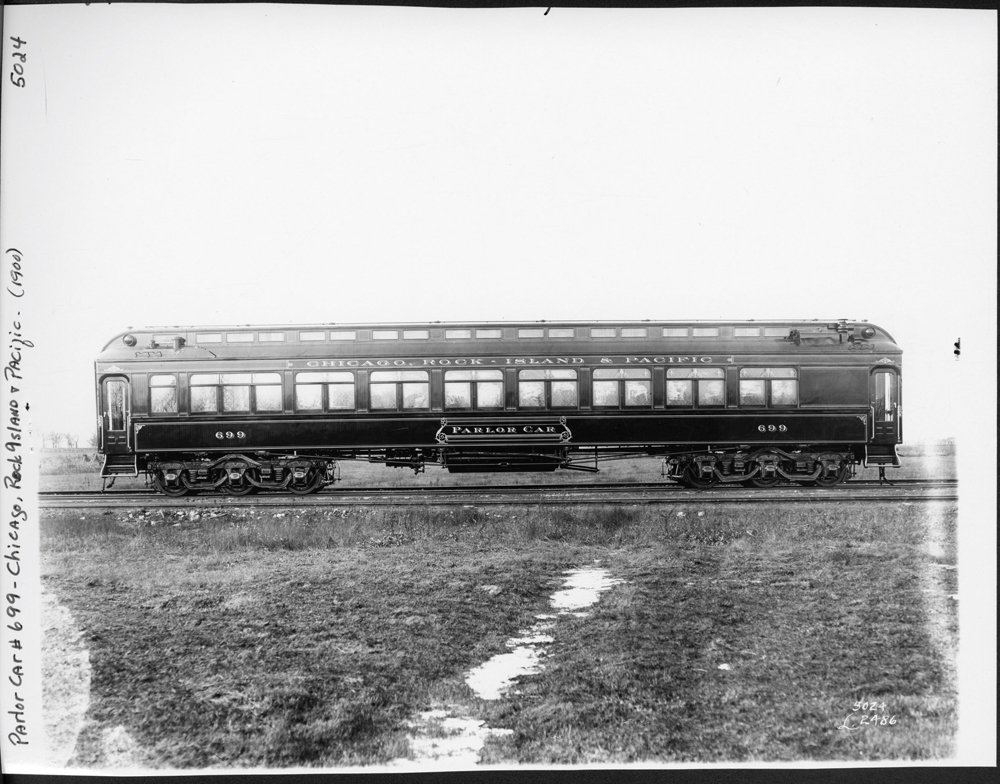
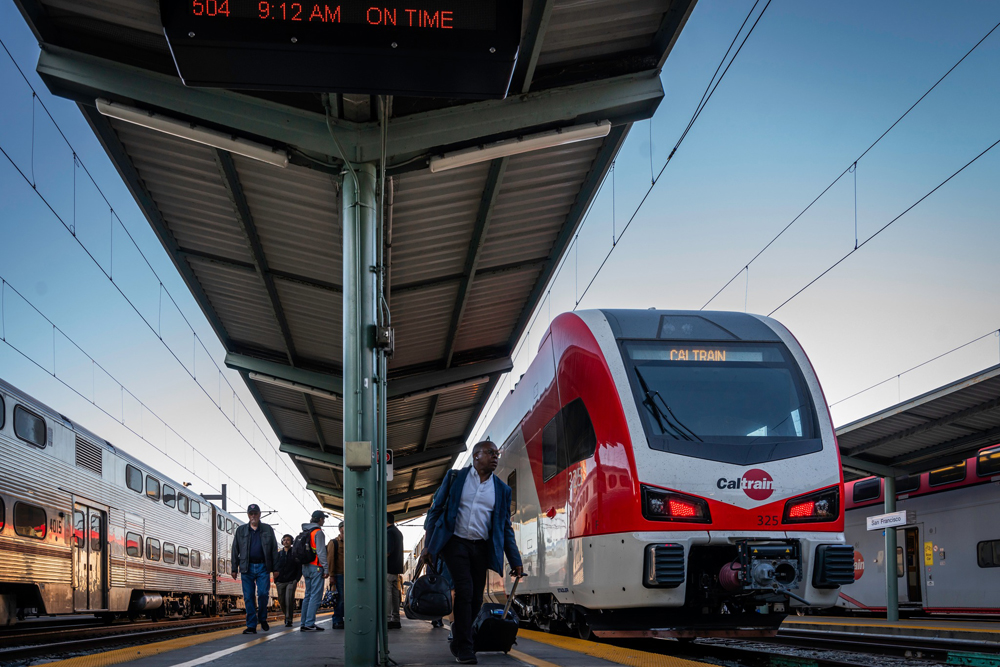
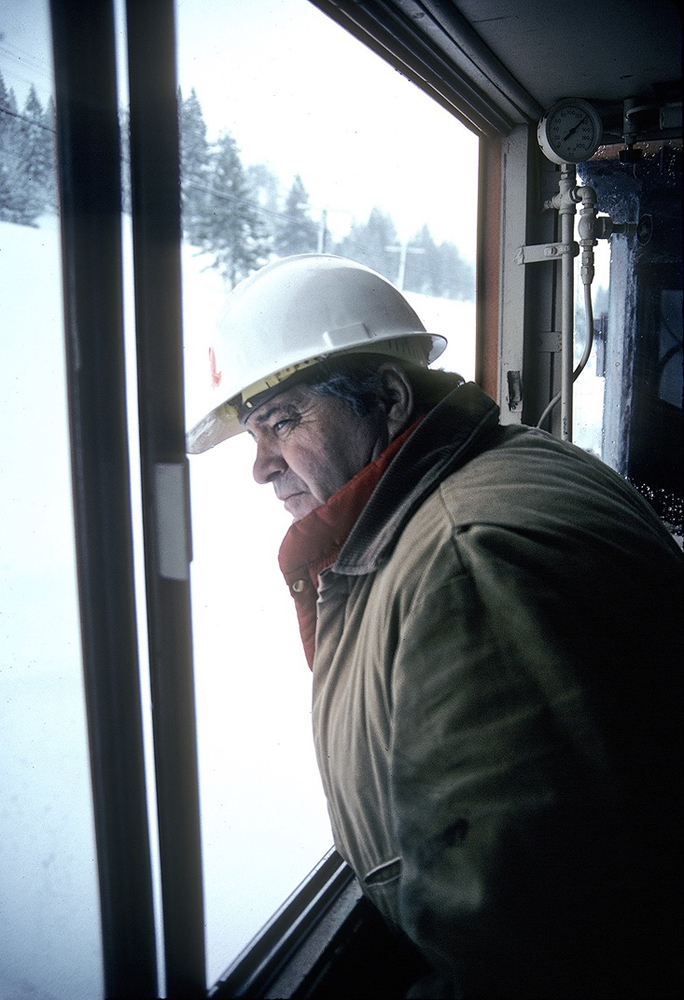
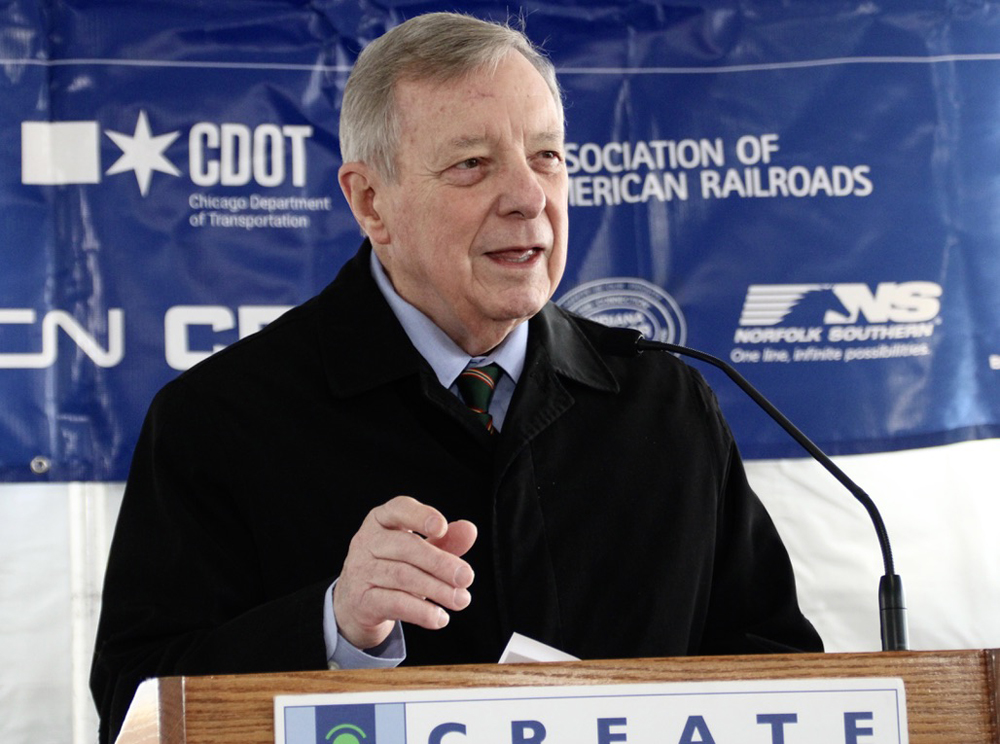




Some great points in comments. At dollars being talked about, wouldn’t Feds & Amtrak at end of day rather have the tunnel connecting Boston North & South Stations to finally give true direct service to Portland, ME and more opportunities to increase frequency. Tie that in with some more infrastructure dollars going into Virginia and NC for states that desire more service & connectivity and you got an ever better rail on Eastern Seaboard. At some point GA and NC are going to convince SC that having multiple transportation options in a growing region is a good thing.
..
Didn’t really think about it but the true loss opportunity for rational rail expansion is lost on these one state plans and proposals with a healthy dose of Freight railroads trying to angle for outright Capex projects that go way beyond what is needed. Would love to see Feds go all in on say proposals that favor multi states, say the added/expanded Empire Service between Chicago & Twin Cities, or go all in on giving Brightline West grant to extend its proposed service to Palmdale as well as help build out rails & Amtrak San Joaquin a little farther south and you will end up with Amtrak, Brightline and Metrolnk interconnecting if not mistaken at one station (if feasible)
This will clash with the move of NS traffic from the Pan Am Southern main line to the B&A. The former is about to become a low-density branch line with a questionable future (possibly abandoned), while the latter risks of becoming mined by congestion and cohabitation issues between frequent, fast passengers trains and heavy PSR-style land barges with 0.4hp / ton.
Off topic but the map clearly shows a point that as a native Bay Stater I have trouble explaining to people in the Midwest. Same issue in Rhode Island and Connecticut. Massachusetts consists of 351 cities and towns. The fourteen Bay State counties are little more than lines on the map, and nothing more than lines on the map in the other two states.
Of the 351 cities and towns in Massachusetts, several have a population under 1,000 and a handful have a two-digit population. Imagine providing municpal services (town clerk, schools, fire, police) with a population of 75. Obviously the smaller towns join into regional groups to provide these services (or send kids to school in New York State) but the towns have to do this. There’s no county government to do it for them.
The multi-billion dollar project cost was from a ridiculous study MassDOT commissioned on true HSR in western Mass that was deliberately designed to turn off support for the idea. To go 150-180mph meant digging extremely long new tunnels and creating almost an entirely new ROW all the way to Boston.
This was intentionally absurd, but surprisingly failed to kill support for the more rational upgrading of the existing CSX/B&A route–which was once all double (and in some places triple) track–an ROW that is still intact except in a few narrowed points nearing Boston. There will be a need for curve straightening, new equipment, and some new stations, but if this project is done as a rational incremental upgrade it will cost nothing like the multi-billion dollar nonsense in the earlier “study”.
What is missing here is the fact that the west end should be Albany, NY and not Pittsfield–thus connecting to the rest of the Amtrak system. This flaw is built into the Amtrak law–alas–which puts the burden for new routes directly on the states.
It is very hard to get multi-state cooperation–even in a case like this where the omission of 49 miles Pittsfield to Albany will permanently negatively impact ridership. But NYDOT sees little value in such a stub, as at best only Albany and perhaps Chatham would be directly served in New York.
Of course this ignores connecting ridership and the substantial commutder market for riders into both Albany and Pittsfield that exists today (and indeed was once served by NYC RDC cars)–but it’s precisely why the states should not be forced to construct multi-state compacts to avoid this sort of trap. This same dilemma undermines creating new inter-regional routes like Chicago to Florida. If even one state refuses to cooperate the entire concept falls apart.
I strongly support the Western Mass plan, but hope some way can be found to get these trains to Albany to integrate with the national network.
Awesome post (above) thank you. Many points described very well. To amplify one point, NYCRR was reduced to single track in Boston and Newton when Mass Pike (I-90) Boston Extension was built starting around 1961.
Today’s MBTA runs a full schedule to Framingham and on to Worcester, whereas in the 1980’s there were three MBTA train pairs (only as far as Framingham) plus one Amtrak pair.
Historically states like Vermont and Maine paid Amtrak for service that travel through several states, no reason why Massachusetts could not pay for the East-West trains to terminate at the Albany-Rensselaer Rail Station, and financially benefit from the dramatically increased ridership and lower start up costs by not having to build out layover facilities in Pittsfield. Question: does MassDOT they even pay for the Boston-Portland “Downeaster” today, what about New Hampshire?
Guest Post: Letter to MassDOT from Steve Strauss, NYS Council Representative – Rail Passengers Association
https://barringtoninstitute.org/guest-post-letter-to-massdot-from-steve-straus-nys-council-representative-rail-passengers-association/
Way back in history, Michigan and New York State paid for a 403b train in Canada. The Niagara Rainbow was pulled when New York State dropped its subsidy. The former Michigan Central line via St. Thomas (Ontario) was abandoned shortly thereafter.
Yes, but still no reason why a state can’t pay for trains that travel out of state, its done today (‘Adirondack’ to Montreal for example) and in fact MassDOT will pay Amtrak to run a train from Albany to Pittsfield for its trial “Berkshire Flyer” this year, so no reason Mass needs NYS to have East-West Rail end in Albany, using existing Amtrak infrastructure and personnel there, saving millions in cost while adding millions in revenue.
Vermont has always paid for the VERMONTER in New Hampshire, as has Maine for the DOWNESTER in the “Live Free (or Die)” state. But the issue west of Pittsfield will probably come down to both traditional Mass-centric parsimony (they don’t pay for CT Rail’s many trains within Mass for example) and to the fairly significant cost of restoring double track over the State Line summit and tunnels between Pittsfield and Chatham.
That is no true reason to balk, only an anticipation of potential objections. NYDOT of course should support this as well, since if properly scheduled added Boston-Albany services would add ridership west and north of Albany in particular.
Let me guess: a bunch of money is needed to reinstall trackage that had been ripped out during the Conrail era.
Bingo!
Why do this? Eastbound, Greyhound offers 1 daily Pittsfield to Boston trip (< 4 hrs) and 2 daily single seat Springfield to Boston trips (2-2.5 hrs) while Peter Pan offers weekend only Pittsfield-Boston trips and 2 single seat Springfield to Boston trips (2 hrs). Amtrak 449 runs Pittsfield to Boston in 4 hrs each day while Springfield to Boston scheduled trip time is 2 hrs and 28 minutes. Prices are pretty comparable. IMO, there's insufficient demand to spend $2+B to accomplish this feat (although CSX may be very pleased).
If you want to know how people travel in the United States, go to Logan Airport in Boston. While waiting for the Silver Line bus/trolley to take me to the Red Line for Quincy, I saw buses to/from all over southeastern New England. One bus after another after another. That’s called “connectivity”. Buses from all over eastern Massachusetts and Rhode Island, some to Maine and New Hampshire, connect to airplanes flying to the entire world.
Or, alternately, you can look at a map and see that Pittsfield and Boston are in the same state and there’s a railroad in between. Therefore we will spend Billions Of Dollars so that a handful of people will ride it.
The really big market here is not Springfield to Boston but Hartford to Boston.
It wasn’t long ago that Peter Pan ran hourly from Springfield to Boston with half a dozen trips going on to Albany.
“suggested ridership would not be enough to qualify for federal funding”
Compare the cost vs. patronage to the cost vs. vehicles per day of a highway project.
Just because a project is within the same state doesn’t mean people will flock to it. The natural flow is to connect all th e way to Albany and west to Cleveland and Chicago.